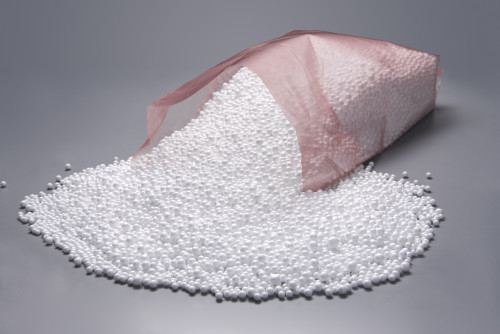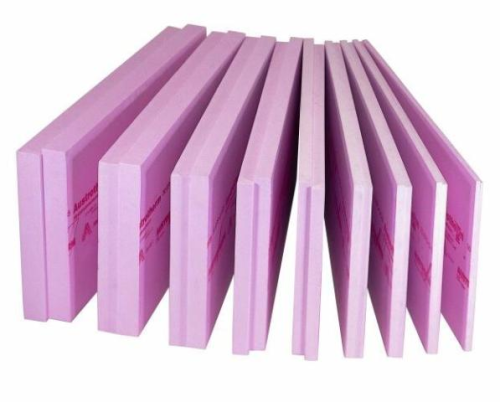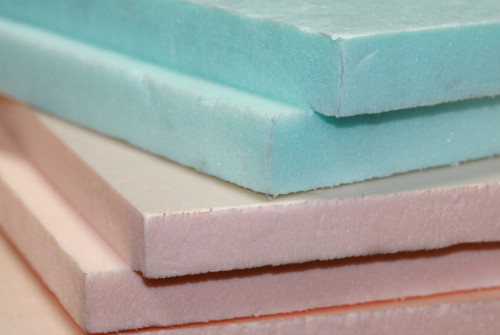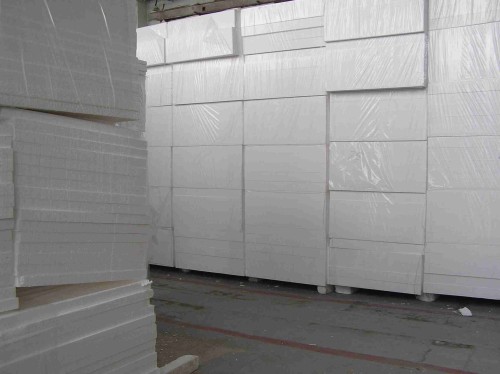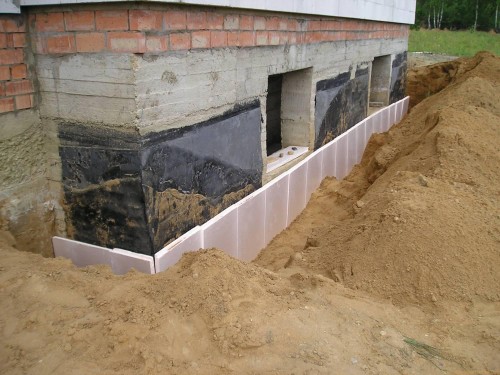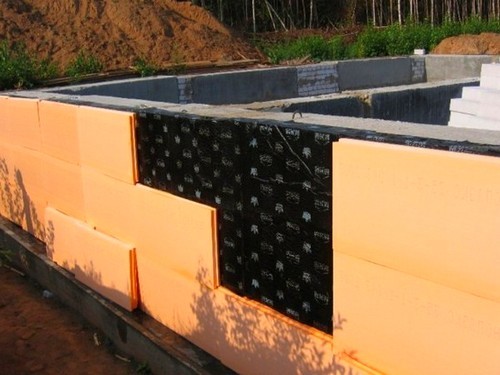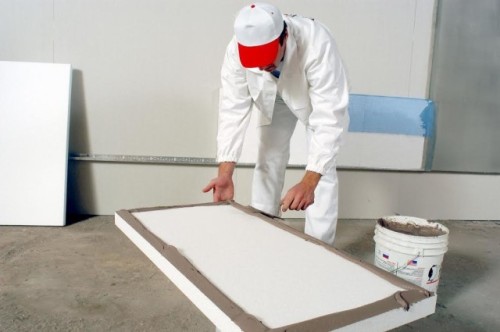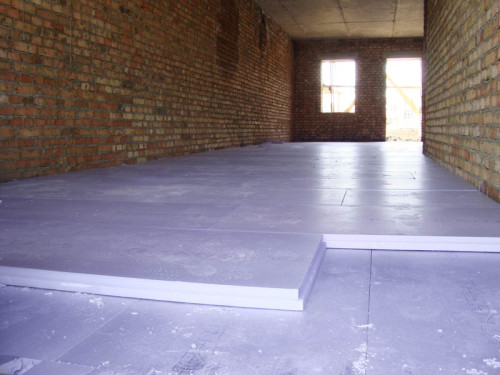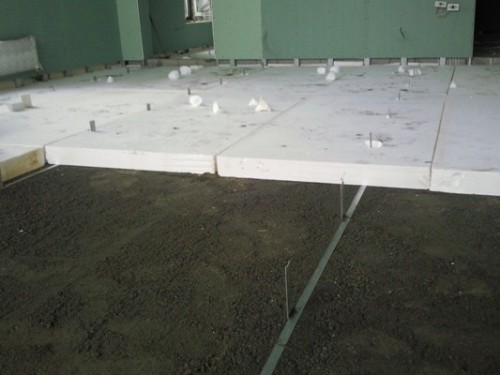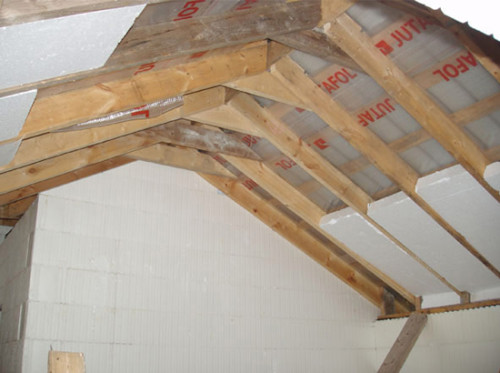Polistyle foam is one of the most popular heater used at all stages of private construction: for the foundation, basement, walls, roofs, etc. Low thermal conductivity, low weight, durability and cheapness are far from all the advantages that this material has. In today's article, we will talk about the technology of insulation with polystyrene with our own hands.
Content
A brief overview of the characteristics
Foam or polystyrene foam is obtained from polymer mass, which is exposed to water vapor under high pressure. As a result of this, polymer granules increase ten times, and foamed material is obtained. In fact, these are millions of air bubbles enclosed in the finest polystyrene shells, which account for only 2-3% of the total volume of the material. Polistyle foam is a solid and fairly strong foam created with one purpose - to retain heat in the room.
The main characteristics of polystyrene foam:
- Teleproduction - mineral wool is the main competitor to polystyrene foam, but if you compare the indicators of their thermal conductivity, it becomes clear that the mineral wool significantly loses. In this case, the thermal conductivity of the polystyrene foam can be varyed by choosing a material of different densities - the denser the structure, the higher the thermal conductivity.
- The vapor permeability is that the usual foam has zero vapor permeability, since dense polystyrene shells of air bubbles are not able to pass wet evaporation. Extruded polystyrene foam differs from the usual one, since the cutting method is used to form it, which means that steam can climb through the cuts.
- Moisturing absorption is a situation with moisture absorption somewhat different. Ordinary polystyrene foam, immersed in water, absorbs 10 times more water than dense extruded polystyrene foam. For this reason, it is recommended to use extruded polystyrene foam. In order for the polystyrene to serve for a long time and continues to retain heat qualitatively, it must be properly protected from getting wet.
- Strength - extruded polystyrene foam is ten times stronger than usual, since it has a denser structure, and, accordingly, the relationship between the molecules is stronger. The bending strength is from 0.4 to 1 kg/cm² while in ordinary polystyrene foam it is 0.02-0.2 kg/cm².
- Sound insulation - many foam sellers claim that it protects equally well from the cold and from noise, but this is not true. Air bubbles can only muffle shock noisy to a small extent and only if the foam is laid in a thick layer and in compliance with the technology. With air noises, which usually cause us discomfort, foam cannot cope.
- Environmental friendliness - there is an opinion that insulation with polystyrene foam from the inside, and in general, the use of this material in the construction of a residential building will adversely affect the health of a person and the environment. In environmental terms, polystyrene foam is safe, but there are several reservations. Firstly, the material is oxidized in the open air, which happens especially quickly with the usual unexpected foam. During oxidation, toxic substances are released into the atmosphere: toluene, formaldehydes, acetophenon, ethylbenzole, methyl alcohol, etc. That is why after laying the foam insulation must be immediately blocked with insulation and finishing.
- The combustibility - if you look closely at the advertising of the polystyrene foam in the construction market, you can notice that many manufacturers focus on the fact that their products in terms of fire safety are harmless than wood. In fact, a lower temperature is needed to fire a tree than to fire polystyrene foam. But before it is caught, it will melt and at the same time release toxic smoke. If the manufacturer assures that its polystyrene foam is capable of daring independently, do not believe. To verify the falsity of such a statement, it is enough to familiarize yourself with the Russian GOST 30244-94, which states that polystyrene foams belong to the group of the most dangerous materials in combustibility-G3 and G4.
Many manufacturers, presenting their products, use European standards for determining the combustibility of a biological, chemical and complex characteristic. Therefore, it turns out that the most dangerous and easily ignited material is wood. The toxicity of the polystyrene foam is determined approximately, since it is not possible to accurately compare the products of combustion of foam and wood. As for the comprehensive verification, which can provide reliable information about the products, it simply is not included in the overall list of technical characteristics. The consumer receives only part of the information, that is, inaccurate chemical characteristics and foggy biological analysis. It is also worth considering that over time, any foam, even with antipypeed additives, literally ages and loses its quality indicators, including the combustibility class (becomes more susceptible to fire).
- Durability - this indicator depends on many factors, from the quality of the material itself, ending with operational conditions and climate. An important role is played by compliance with installation technology and the use of suitable adhesive and protective mixtures. If the insulation of walls with polystyrene foam is carried out according to all the rules, the material is guaranteed to last 25-30 years.
How to choose polystyrene foam
The most important mistake when choosing polystyrene foam for insulation is the wrong calculation of the thickness of the plates. Many people think that the thicker the insulation, the better, but not only does it lead to an increase in cash expenses, and also reduces the service life of the insulation itself and walls.
Foam is one of the cheapest heater, with the styling of which you can cope without professional skills. That is why the demand for it is so great, and since demand gives birth to a proposal, the varieties of polystyrene foam, if not too much. An ignorant person will immediately be confused in such a variety, and he will have no choice but to trust the sales consultant. Many manufacturers deftly play, promoting not what is suitable specifically in your case, but what needs to be sold. Therefore, before going for polystyrene, conduct a detailed analysis: what will you warm, for what purposes, climate features in your region, financial capabilities, etc.
If you need to insulate the walls of the house outside, choose PSB-S polystyrene at least 40 brand. If you see a number 25 or less on the marking, such a material is unsuitable for any construction work. After determining the brand, select the density of the material-for PSB-C40, it can vary from 28 to 40 kg/m³. Be sure to pay attention to the density, and not just the brand!
Useful advice: if you are assured that the density of the selected polystyrene foam is not lower than 35 kg/m³, specify how it was produced. The usual method allows the foam with a density of not more than 17 kg/m³, while better material can only be made by extrusion (strong pressure).
Finally, break off a small piece from the corner of polystyrene foam - if the edges break off unevenly, and small balls on the breakup will be visible, then the quality of the product is low. High -quality extruded polystyrene foam is broken off evenly, and on the breakup you will see the right polyhedra.
Features of insulation of polystyrene foam
Despite many claims to polystyrene foam, it remains the most popular insulation for many years. There are more reasons for this than complaints: it is cheap, easily cut, easily mounted, serves for a long time and holds heat well. However, the main thing to remember when warming is to close the polystyrene layer with insulation as soon as possible to protect it from direct sunlight and oxidation. To do this, use special plastering mixtures on an external finish and drywall - for the internal one. Next, we will tell you how to use polystyrene foam to warm the main parts of the house.
Insulation of the foundation and base
Since the construction of any house begins with the foundation, consider the technology of its insulation in the first place. If you insulate the foundation, then instantly increase the thermal insulation indicators of the whole house, and also prevent freezing of the soil. This means that you will need less money, effort and time to insulate the floor, walls and roofs, and the foundation itself will last longer, since it will not freeze and thaw annually.
The technology of insulation of the foundation with polystyrene foam:
- You can warm the foundation at the stage of building a house and even after commissioning. In the second case, the foundation must be completely digging around the entire perimeter, cleaned of dirt, rust and any spots. If there are remains of rolled waterproofing on the outer walls, they need to be removed. It is possible to warm the foundation, like walls, both outside and inside, but experts all as one advise doing this outside.
- For insulation of the foundation and basement, it is better to use extruded polystyrene foam, given when choosing its density and calculated thickness. The density should be at least 35 kg/m³.
- Before attaching polystyrene foam, it is necessary to waterproof the outer walls of the foundation. For this, any materials are suitable with the exception of bituminous mastic on organic solvents, since when in contact with polystyrene foam, it will quickly destroy it. If you want to use mastics, choose water or polymeric mixtures.
- Now you can attach foam polystyrene slabs. Use a special glue for this, designed exclusively for polystyrene foam. Apply it around the entire perimeter and a couple of stripes in the center, wait a minute so that it will make it and tightly press to the wall for 2-3 minutes. Fasten the plates by level to prevent distortions at the points of connection. If you are going to lay polystyrene foam in two layers, fasten the sheets of the second layer so that their seams are displaced with respect to the seams of the lower layer by half the stove (seam dressing). Fill the cracks left after fixing the plates with mounting foam.
- Even extruded polystyrene foam does not have high mechanical strength and is subject to various damage, including corruption rodents. For this reason, after laying the plates on top, you need to attach a reinforcing grid or wooden shields. Fix them with dowels around the perimeter of the foundation to the height of its backfill. If you use a grid, you need to apply a cement plaster with waterproofing additives on top of it.
- If you insulate the foundation of a house located on a wet soil with a high level of groundwater, it is necessary to do drainage. To do this, around the entire perimeter of the house, a perforated pipe is installed, laying it on the powder of sand and gravel. Pour the foundation in this case with sand or soft soil.
- To insulate the basement with the polystyrene, the plate must first be glued to the prepared base, and after 1-2 days, when the glue hardens, strengthen the fixation with dowels-zontics. Each plate should be strengthened by 3-5 with such dowels. To reduce the number of fasteners, the umbrella can be installed in the joints between the plates. To protect the polystyrene foam from atmospheric and mechanical effects on it, it is necessary to lay a painting grid and plastering the surface with a mineral mixture. After that, you can proceed to decorative cladding.
Despite the popular practice, it is better not to insulate the foundation with foam - this is not quite suitable for such operational loads. Experts recommend replacing polystyrene foam with more durable analogues: a foam or polyurethane foam.
Wall insulation
Many mistakenly believe that there is no difference between the insulation of the walls outside and from the inside, moreover, it is much easier to warm the walls from the inside, because you can do this at any time of the year and do without equipment for high -altitude work. However, in reality, everything is quite the opposite - experts recommend not to warm the walls from the inside without extreme necessity. And such a need can arise only if the house represents architectural or historical value, or if the insulation of facades with polystyrene foam is impossible for technical reasons.
What problems arise with internal wall insulation:
- The dew point - a place where the cold temperature from the street collides with heat, going from the inside of the house - moves inside the room into the space between the insulation and the wall. As a result, dampness accumulates there, a fungus, mold, the wall develops.
- Since the wall is gradually destroyed from moisture, the service life of the building itself is also reduced several times.
- Inside the walls of which are insulated from the inside, there is constantly increased humidity, and if you do not provide additional ventilation of the rooms, the interior and furniture will also begin to deteriorate. Moreover, due to changes in the internal climate, the health of residents will suffer.
- To warm the walls from the inside, a layer of thermal insulation should be thicker than for external work. This leads to an increase in expenses and a reduction in useful internal space.
All these factors in total lead to the rapid destruction of the walls of the house and uncomfortable living, and therefore it is better to immediately conduct insulation with polystyrene by polystyrene. You will find more useful information about this in the article "Warming the facade of the house with polystyrene".
Floor insulation
Even if you have insulated the foundation and base, this does not mean that the insulation of the floor can be neglected. This issue is especially acute for residents of the first floors of multi -storey buildings and owners of private houses. The insulation of the floor with polystyrene foam can significantly reduce heating costs, and also eliminate the causes of “household” diseases associated with hypothermia.
If you work with the floor on the lags, it is better to use PSB-C15 polystyrene foam for insulation, since the main load will not be on them, but on the lags. In terms of power for thermal insulation of floors, 10 cm is required on the first floors, and for inter -story ceilings - 5 cm.
For insulation of concrete coatings, you need a more durable polystyrene foam from PSB-C35 and above. First, gross alignment with slabs of various capacities is carried out, but experts advise to make a leveling screed before warming. Before laying the heater slabs on the floor, put a waterproofing film. Polistyle foam is covered with a 2 cm layer of cement mortar, in which the reinforcing mesh is spilled, after which they make a final screed 5-8 cm thick. Technological gaps around the perimeter are filled with fiberglass or mounting foam.
The insulation of the attic
Recently, many began to redo the attics into cozy attics, thereby increasing the useful living area of \u200b\u200bthe house. But so that there it is truly warm and comfortable, the walls and ceiling must be heated qualitatively. In this case, there is no particularly strong load on the surface, but the insulation is exposed to other effects. Since the attic is under the roof itself, all the warm air from the house rises there, and if you do not create a serious barrier for it, it will simply leave the house, and you will spend a lot of funds on heating. For the same reason, the attic is always a few degrees warmer than on the lower floors of the house.
The ceiling on the attic is more susceptible to the formation of condensate than other floors in the house, so it needs to not only be heated qualitatively, but also take care of vapor barrier and ventilation.
The insulation of the attic foam polystyrene occurs according to more stringent requirements. This topic is considered in more detail in the article "Roof insulation with foam".
Below on the video - insulation by polystyrene with a mansard room:
Polistyle foam can serve as an excellent help to create a warm house for many years, but only if you carefully study all aspects of its use.

